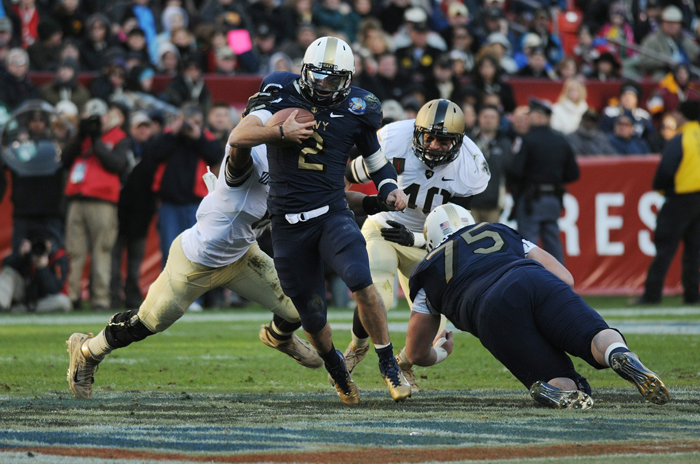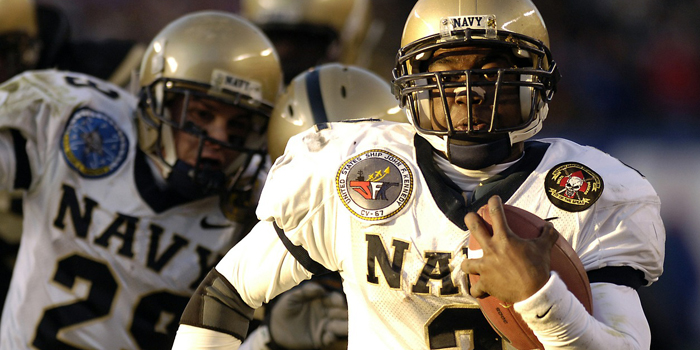
If you were to ask anyone in professional or collegiate sport what athletic attribute is the most important, everyone would unanimously say speed. We all know the catchphrase “speed kills,” but something in the training of team sports is lost when we see the lack of speed training and a focus on conditioning. The hardest quality to improve is an athlete’s speed. Genetics matter more than we want to admit and are often a fair excuse when we don’t have the blessed on our roster. Without distilling too much, testing maximum speed is a smart way to prepare athletes for athletic performance.
The Value of Maximum Velocity
How fast an athlete runs linearly is underappreciated for many reasons, but top speed or max velocity is a great representation of how well prepared an athlete is. By addressing maximum velocity, a coach is making the choice to expose athletes to forces they may need to see, such as a big play in American football. Sometimes maximal speed is important for injury reduction to muscle groups that are at risk during acceleration. Maximum velocity mechanics and the training to improve it help running economy and even warming up and rehabilitation. Obviously, acceleration is extremely important, but we see enough efforts in that quality with weight room protocols and the equipment used. Very few general qualities transfer to maximal velocity outside running at top speed in training. The reason I'm such a proponent of maximal speed development is that I see so many injuries because the running program was eliminated in favor of more training in the weight room. A sound strength program is essential, but athletes tend to pull more muscles running than they do squatting and snatching, so it would be a good idea to address the problem at the source.
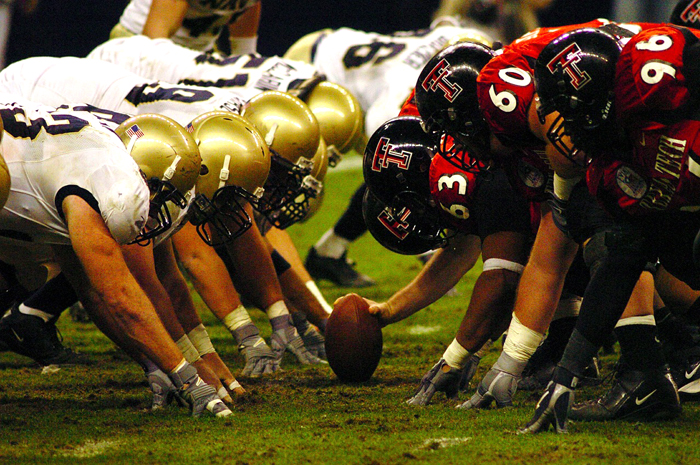
GPS and Modern Football
About a decade ago, GPS and video player tracking in soccer and rugby took off in clubs, and I anticipated several problems with American football using this technology. First, unlike soccer and continuous sports, football has set time intervals and probable time of play characteristics. Second, the offense is scripted on distance of plays, and while some break the planned distance, most perform as expected in terms of distance and effort. Remember, plays are typically full speed, and the field is a giant ruler, which is evident by the painted lines and numbers. Coaches with the right education can benefit from GPS or tracking technologies, but teams are trying to look at skill positions more because the data from offensive linemen isn’t as valuable.
The primary problem with GPS tools is that they aren't leveraging what they do well and they encourage team coaches to be lazy in what they should be better at—planning. GPS is about the volume and distribution of work, but it’s a difficult way to understand speed and not the best way to evaluate it. “Why?” you ask.
GPS and technologies are continuously measuring and can’t analyze beyond the player tracking metrics. Technology sometimes replaces people, but in this case, the technology should be adding roles because so much data is there. If you were to see the top four vendors in GPS data, their data looks very similar to a spreadsheet of estimated splits that one sees in track. However, instead of time, they have rates of work. In order to fully appreciate the data of any GPS vendor, one needs to have pure data for comparison purposes. This is why I've helped teams use those products to recalibrate the data.
Testing the 50-Yard Dash?
When I test an athlete's speed, I look at the likelihood of that athlete being able to run at a high velocity, and that is very dependent on two factors. First, the player's weight limits his top speed. A 245-pound linebacker isn't likely to run 12 meters per second. Second, an athlete needs enough distance for sprinting to achieve maximal velocity. An overweight NFL lineman running 40 yards will hit his top speed likely in the second half of his test because his weight and the distance limits him. Testing 40 yards may not indicate that a wide receiver or cornerback has hit his limit in maximal velocity.
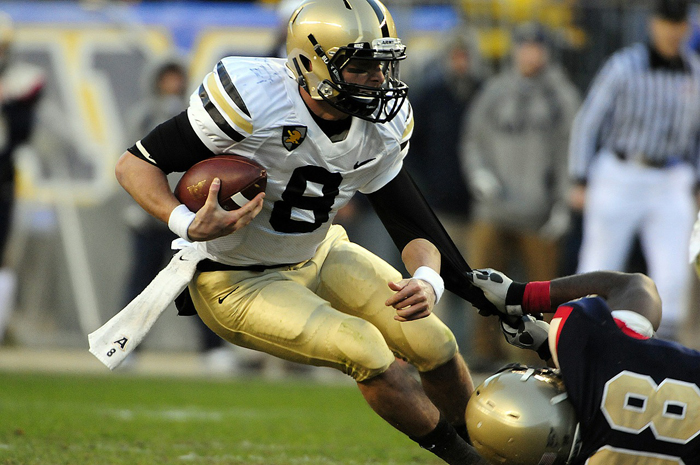
Coaches are left with three options with skill positions: test longer, test differently or accept the limitations of the data. My suggestion is to do what is best for your program and decide based on risk tolerances and political constraints. I prefer only to allow athletes who have earned the right to sprint longer to get tested in the 50-yard length or longer, and I focus on most of the athletes’ 30–40 distances as being a cutoff point. Some coaches have used the 30-meter or 30-yard distance as a conservative test length for linear speed, but this doesn’t help the program in the long term. Athletes need to think about career durability and performance down the road.
Body Speed Is the Ultimate Metric
The problem with American football is that there is too much talk about performance metrics in imperial units (pounds and yards) instead of the international standards of the metric system. Sport science is a global study; coaches should use metric units. The American passion for cars encourages coaches to talk about miles per hour instead of meters per second.
Anticipating all of this a decade earlier, I knew that I had the challenge of not only changing the units of measurement but also the representation of the data so people could be on the same page. The best information on speed is from track and field, and for the last century, nobody ran yards in the 100. My solution for creating clarity is to test the distance that people are comfortable with and not ruffle feathers but then convert the times into meaningful velocities that can be used with other data points. For example, maximum aerobic speed is in meters per second in many studies, so it would be wise to convert to this expression of output. The imperial units that Americans have grown to love is a dying language, but we're still speaking it and must translate what we are saying to others, hence my collaboration with Freelap USA. With so much focus on what device can express weight room power, we lost sight of the purpose of the training there—to get bigger and faster.
Velocity-based training from Bryan Mann and other noted innovators such as Mladen Jovanovic are bridging the gap with weight room metrics, but as a track coach, timing speed is important.
The Conversion Formula and the Speed Table
For three years, I've been collaborating on simple formulas and tables for coaches to do what they want to do: make confident choices on their testing results. In order to improve athletes, one must make decisions on strong evidence, such as testing data of training. While not perfect, some tests can give strong indicators of what an athlete can do at that moment in time, and coaches can decide what they need to do in the future.
In the 40-yard dash, each 10-yard segment is a rough indicator of acceleration, and the last segment can represent an athlete’s maximum speed if he is heavier or doesn’t have outstanding maximal speed qualities. Most team sport athletes won't accelerate or hit maximal speed after 40 yards, but some may, especially if they're using a standing start and have normal power and speed levels.
No matter what test you perform or segment you choose, be it a 40- or 50-yard segment or the 30- or 40-yard segment, you can convert the split into meters per second with this simple formula:
(10 yard/time split) * 0.91 = max velocity m/s
For convenience, here's a full table so that coaches can quickly see their splits match with the corresponding velocities.
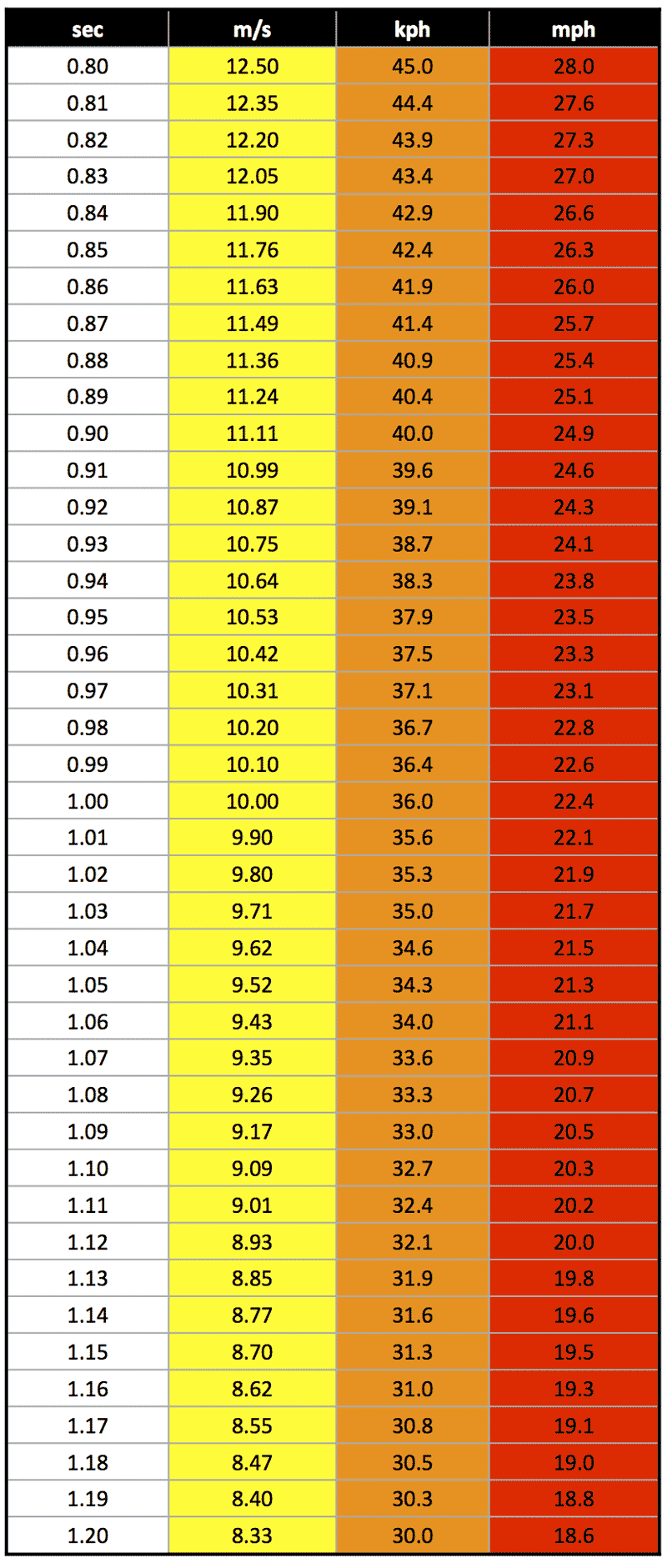 We'll say an offensive lineman in college runs a 0.97 “flying 10-yard” split in the 30–40 yards. His maximal velocity is 9.3 m/s. The assumption is that if he was timed from 40–50 yards, it wouldn't be faster, and given the split time, it’s unlikely because large athletes near 300 pounds will have poor maximal speeds compared to acceleration abilities. Based on combine tests of the first 10 yards and broad jump scores, linemen are traditionally well prepared for the first 5 yards. This observation is statistically supported by past testing data.
We'll say an offensive lineman in college runs a 0.97 “flying 10-yard” split in the 30–40 yards. His maximal velocity is 9.3 m/s. The assumption is that if he was timed from 40–50 yards, it wouldn't be faster, and given the split time, it’s unlikely because large athletes near 300 pounds will have poor maximal speeds compared to acceleration abilities. Based on combine tests of the first 10 yards and broad jump scores, linemen are traditionally well prepared for the first 5 yards. This observation is statistically supported by past testing data.
Why is this important? We want this number so that we can see how fast an athlete can be and have an indication of maximal output with regards to velocity relative to one’s acceleration. Most athletes in sport run 5–15 meters in activities, so if you get crude splits every 10 yards, coaches can get estimations of work and relative effort.
Most of this data is important to skill athletes who are lighter and cover more distance, but it also gives context to short acceleration zones. What we see in sport is the gradual increase of total output with both speed and distance covered, forcing coaches to be more sophisticated in finding ways to prepare athletes to handle the work and speed requirements.
So that team coaches can understand speed in a broad perspective, I collaborated with Freelap USA to create a simple table to see how splits (10y or 10m) and segments can be seen in different speed expressions. This table includes splits in meters so you must use the formula found above first before you can see the speed in kilometers per hour or miles per hour outside meters per second.
Closing Thoughts on Maximal Speed
The purpose of the formula and table is to create a framework for an athlete’s capacity to express his power in a locomotive manner and nothing more. Clearly, we need to see an acceleration in peak form (maximum rate of acceleration) and the decay of all maximal speed qualities in order to measure fatigue indices. For teams, capturing maximal velocities profiles capabilities in a practical manner and guides performance coaches on what to work on and what maybe is best to leave alone. When expanding to all sports and the top athletes in each respective discipline, tables such as the speed chart can serve as a roadmap for development over an athlete’s career.
Since 1997, Carl Valle has coached track and field from high school to the Olympic level in the sprints and hurdles. Having the privilege of working with great athletes who have been All-American and school record holders, many rewarding experiences made Valle love both the sport and working with great people. After years of seeing athletes fall through the cracks in the US and abroad, Valle decided to create a unique solution to leverage the great coaching community and medical network by organizing those resources.









